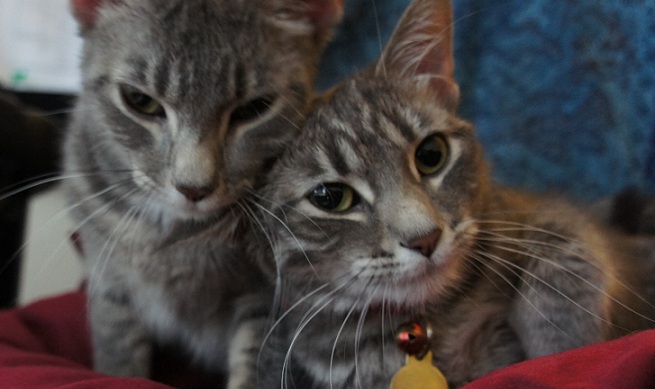How to foster a cat through a rescue group or shelter
 Your community probably has a need for more foster homes for cats.
Your community probably has a need for more foster homes for cats.
To foster a cat means to provide her with a loving home while she waits to be adopted.
Some people choose to foster for a few weeks or months until the cat finds her permanent home. Others foster on a short-term basis to give the cat a break from shelter life.
There is also a need for people to foster a mother cat and her newborn kittens or a litter of orphaned kittens until they are old enough and healthy enough to live at the shelter.
Many rescue organizations do not have actual shelters and depend entirely on foster homes. Most of these cats are rescued from the pounds where they would’ve been killed.
Becoming a foster owner is definitely a way to save a cat’s life!
How to foster a cat
Make sure your home is appropriate for a cat.
I’m sure you know whether or not your home is appropriate for a cat, but here are some extra questions to ask yourself:
- Will you be traveling in the near future? You probably won’t want to leave a new foster cat home alone for a long weekend right away, for example. Also, what will you do with your foster cat if you leave for a week on vacation?
- Do you have a lot of new furniture? Your foster cat might do some serious scratching!
- Will your landlord approve of another cat in your apartment?
- Do you have a room you can block off from the rest of your house while your foster cat adjusts?
- Who will pay for the cat supplies? You? Or the rescue group? Some rescue groups will provide or pay for all the supplies. Some won’t.
Fill out the foster home application.
Search online to find the different rescue groups and shelters in your area. Most of these organizations will have their fostering information right on their web sites, along with a foster home application. If the shelter doesn’t seem to have a fostering program, contact it anyway and ask. Having foster homes in place is an important part of saving more animals.
The foster application will likely ask for information about your household such as whether or not you have kids. If you rent, you may need to provide your landlord’s contact information. If you have pets, you may need to provide their vet’s phone number as a reference. You may also need to provide a personal reference or two.
Finally, a volunteer with the rescue/shelter may ask to visit your home to make sure it is a safe environment for a cat. This is standard procedure with certain organizations, but not all.
Contact the rescue again in a week or so.
Rescues and shelters are often slow on communication. Be patient. If you don’t hear anything in a week or so, send an email to make sure your application was received. If you still don’t hear anything, try calling or visiting the shelter during adoption hours.
Even if your application was received and processed, don’t assume the shelter will contact you. Shelter workers are not always skilled in customer service. You may need to be the one to contact the shelter and ask if there is a cat available for you to foster.
Once you know you have been approved as a foster home, the shelter might provide you with a foster home handbook (some have this, some don’t). You may be required to fill out a liability form, and you may be required to attend a foster home training class. It all depends on the shelter’s policies and how organized it is.
Finally, the shelter should be able to help you pick out a cat to foster. Again, don’t assume the organization will automatically contact you. Check in with the person in charge every few weeks if you don’t hear anything.
Think about the type of cat you want to foster.
Think about your own schedule and what kind of cat you could realistically accommodate. If you are home a lot, you may be available to take on a young kitten or two or a cat that is recovering from a spay surgery. If you work long hours, your house may be better suited for an older, quieter cat.
Personally, I will only foster cats that have been spayed or neutered, for behavioral reasons.
Make sure the foster cat is up to date on vaccinations.
For the protection of your own cats, you should verify that the foster cat has been checked by a vet. The cat should be de-wormed, treated for fleas, given vaccinations (rabies, feline distemper) and tested negative for feline leukemia/FIV.
Cats from a shelter or pound have been around a lot of animals in a stressful environment where diseases can spread. There is always a risk your foster cat could be sick. That’s why it’s best to confirm the cat has had a recent exam.
Reputable rescue organizations will have no problem providing you with a copy of the cat’s vaccination/exam records. It’s best to get these kinds of details figured out before you actually take the cat home.
Prepare an area of your house for the foster cat beforehand.
I like to keep the foster cat in a separate room of the house for at least a day. This is less overwhelming for the cat, and it keeps her out of trouble and separated from my own pets.
I recommend you get all the foster cat’s supplies situated before you bring her home. Prepare her food and water bowls and a litter box. If you have a scratching post, a bed or toys for her, get those items ready as well.
How to introduce your foster cat to your home
 The following is the process I use when introducing a foster cat to my home and pets. If you have your own ideas, experiences or questions, please share!
The following is the process I use when introducing a foster cat to my home and pets. If you have your own ideas, experiences or questions, please share!
Bring the cat home in a cat carrier/kennel.
You may need to pick your foster cat up directly from the pound. Or, she might already be at a shelter or temporary foster home. Every organization has a different system.
When I pick up a foster cat, I make sure to bring my own cat carrier. If you don’t have one, ask the shelter ahead of time if it will provide one. With the cat in a carrier, she will be safe in your car and unable to bother you while you drive. The carrier might also help her feel more secure because she’ll have a place to hide.
I always pick up the foster cat at a time where I know I will be able to go straight home and remain home for at least a few hours. I don’t like to drop a new cat off and then go straight to work, for example. I like to know the cat is at least somewhat comfortable before I leave again.
If the shelter is providing you with any supplies for the cat (food, medications, litter), don’t forget to pick those items up as well. At the very least, ask if you can bring home a few scoops of whatever food the cat is used to eating. Mix that with the food you plan to feed her.
Keep the cat in a separate room temporarily.
To help the foster cat feel comfortable at my house, I always keep her in a separate room for the first day or two as described earlier. This prevents my own animals from getting too up close and personal right away.
Most cats need a day or two to relax. Then they are ready to explore and meet the other pets. It’s best to take things slowly.
Slowly introduce your own pets one at a time.
When the foster cat arrives, my own pets spend some time lingering by the door leading to the “foster cat’s room.” The foster cat is typically curious about my animals, too. By waiting a day or two to officially introduce them, they are already getting acquainted by listening and smelling through the door. You could also allow your pets to smell a blanket your foster cat has slept on and vice versa, but I find this isn’t really necessary.
I introduce the foster cat to each of my pets one at a time, starting with my calmest cat, Beamer. I allow Beamer to walk into the “foster cat’s room.” He maintains a relaxed posture, and my foster cats respond well to him.
Next, I invite my retriever mix Ace. He is 70 pounds, so I have him lie down and stay so he is not so scary. Typically the foster cat will approach him with curiosity. I do not allow Ace to make direct eye contact with the cat or to show any excitement. The foster cat typically recognizes right away that Ace is nonthreatening 🙂
Finally, I introduce the foster cat to my sensitive cat, Scout. He tends to get very tense and vocal, and that doesn’t exactly help anyone relax. By this point the foster cat has adjusted pretty well and typically chooses to completely ignore Scout’s nervous energy!
Allow the cat to explore a larger area.
On about the second or third day, I allow the foster cat to venture beyond “her room.” The cat typically explores a small area and then darts back. She repeats this over a day or two, slowly getting braver each time. After a few days, she is usually running the place as though she’s lived here all along.
Always separate the animals when left alone.
At night and whenever I am not home, I always separate my foster cat from my other animals, at least for the first few weeks. Once I know everyone will get along, I might leave them loose, depending on the cat.
Spread the word about your great foster cat!
If the shelter or rescue group has adoption events, try to bring your foster cat to as many of these as possible. There are so many cats looking for homes that you really do need to do what you can to make yours stand out. Make sure to send the rescue updated pictures and descriptions of your foster cat to help with marketing. Videos are good, too!
What tips or questions do you have about cat fostering?
How could anyone say no to cat fostering? Just look at my last two foster kitties! 🙂


Jenny Kalahar
Monday 25th of February 2013
Great article! I am trying to promote the idea of businesses fostering cats or dogs for their local shelter(s). When my husband and I had a used bookshop, we fostered and found, over the years, loving homes for more than fifty cats. Fostering there took the stress level for the cats way down. They had room to roam, lots of customers to pet them (and to get attached to them!), and it gave them great, relaxed exposure to people that ordinarily wouldn't think to run out to the humane society. Other businesses in that town fostered cats, dogs and even rabbits, and it kept the shelters almost kill-free!
shanendoah@life by pets
Wednesday 19th of December 2012
I just saw that CATS Cradle of Fargo won the Animal Rescue Site shelter challenge and is getting $5k! Congratulations to that community.
Lindsay Stordahl
Thursday 10th of January 2013
Yes, that was great! I'm glad you noticed that!
rachel
Tuesday 18th of December 2012
Great tips! I fostered a few kitties this year and took in a stray momma cat. I would love to do it again! The best was watching them come out of their shells and learn that dogs can be nice friends for a cat. The one that was the most terrified of them, now lives with a crazy terrier and they play and cuddle together all day. So cute!
Lindsay Stordahl
Monday 7th of January 2013
I love your pics of your cats with your dogs. I wish mine would cuddle together every once in awhile!
Mayra Calvani
Friday 14th of December 2012
Hi Lindsay,
I'm happy to say I adopted a homeless kitten a few months ago. He was left in a box with his brothers and sisters in front of my vet's door when they were only a few days old.
I named him Ramses...and he's brought such a joy into our home--even though he's a little terrorist at times. LOL. Fortunately, all of the kittens found a home.
Happy holidays and keep doing all the great work you do!
Mayra
Lindsay Stordahl
Tuesday 18th of December 2012
Mayra,
Thank you for taking the time to stop by and leave a comment. I'm so happy to hear you adopted a kitten. Ramses is one lucky kitty! Happy holidays to you as well!